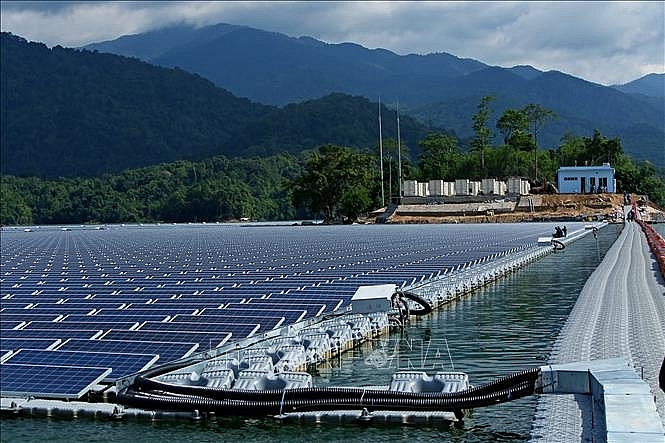First large-scale floating solar photovoltaic installed in Vietnam
 |
| Vietnam's very first floating solar photovoltaic power facility installed on a reservoir. Source: VNA |
Today, the Asian Development Bank (ADB) signed a $37 million loan agreement with Da Nhim-Ham Thuan-Da Mi Hydro Power JSC (DHD) to finance the installation of a floating PV solar power facility on the man-made reservoir of DHD's existing 175MW Da Mi hydropower plant.
The project marks the first large-scale installation of floating solar PV panels in Vietnam and will be the largest installation in Southeast Asia.
“This project will help boost the share of renewable energy in Vietnam’s overall energy mix and decrease the dependence on imported fossil fuels such as coal,” said ADB Private Sector Operations Department deputy director general Christopher Thieme.
“The pairing of these two clean energy technologies – hydropower and solar – is a simple but highly innovative achievement which can be replicated elsewhere in Vietnam and across Asia and the Pacific,” he added.
DHD, a subsidiary of Vietnam Electricity (EVN) Power Generation Corporation 1, currently owns and operates four hydropower plants: Da Mi (175MW), Ham Thuan (300MW), Da Nhim (160MW), and Song Pha (7.5MW). DHD’s total generation capacity is 642.5MW, about 1.7 per cent of Vietnam’s total generation capacity.
“We are proud to be the first company in Vietnam to construct a floating solar power plant on a hydropower reservoir,” said the chairman of the Board of DHD, Nguyen Trong Oanh.
“This project aligns with DHD’s strategy of investing in renewable energy to decrease dependence on fossil fuel, contribute to energy security, mitigate climate change, and promote environmental protection and sustainable socio-economic development. Hydropower reservoirs in southern Vietnam have vast solar power potential. Capitalising on the strong relationship between EVN and ADB, we have worked together to catalyse a new source of power for the country.”
The financing package includes a $17.6 million loan from ADB’s ordinary capital resources. This is supplemented by $15 million of blended concessional co-financing provided by the Canadian Climate Fund for the Private Sector in Asia and its follow-on fund, the Canadian Climate Fund for the Private Sector in Asia II. These funds were established by the Government of Canada to encourage private investment in climate change mitigation and adaptation projects in Asia and the Pacific.
The package also includes a $4.4 million parallel loan from the Leading Asia’s Private Infrastructure Fund (LEAP), supported by Japan International Cooperation Agency through a $1.5 billion equity commitment. LEAP is focused on delivering high-quality and sustainable private sector infrastructure projects that reduce carbon emissions, improve energy efficiency, and offer accessible and affordable healthcare, education, and communication services to ADB’s developing member countries.
What the stars mean:
★ Poor ★ ★ Promising ★★★ Good ★★★★ Very good ★★★★★ Exceptional
Related Contents
Latest News
More News
- Driving double-digit growth through green and circular transformation in Vietnam (December 17, 2025 | 09:00)
- Standard Chartered and ACCA deepen collaboration to develop Vietnam’s talent for a sustainable future (December 15, 2025 | 18:18)
- Schaeffler reports strong early output from Dong Nai solar project (December 12, 2025 | 15:16)
- Forestry conference highlights biodiversity and sustainability goals (December 09, 2025 | 13:35)
- Home Credit honoured among top 10 sustainable companies in trade and services (December 09, 2025 | 12:18)
- SCG and seven member companies honoured in Top 100 Sustainable Businesses 2025 (December 08, 2025 | 09:00)
- Nestlé Vietnam pioneers sustainable development and promotes business connections (December 06, 2025 | 12:09)
- CSI 2025 highlights rise of Vietnam’s green champions (December 06, 2025 | 09:00)
- Acecook Vietnam named among top 100 sustainable businesses (December 06, 2025 | 08:00)
- Vietnam’s forest carbon credits draw global interest (December 05, 2025 | 17:41)

 Tag:
Tag:



























 Mobile Version
Mobile Version